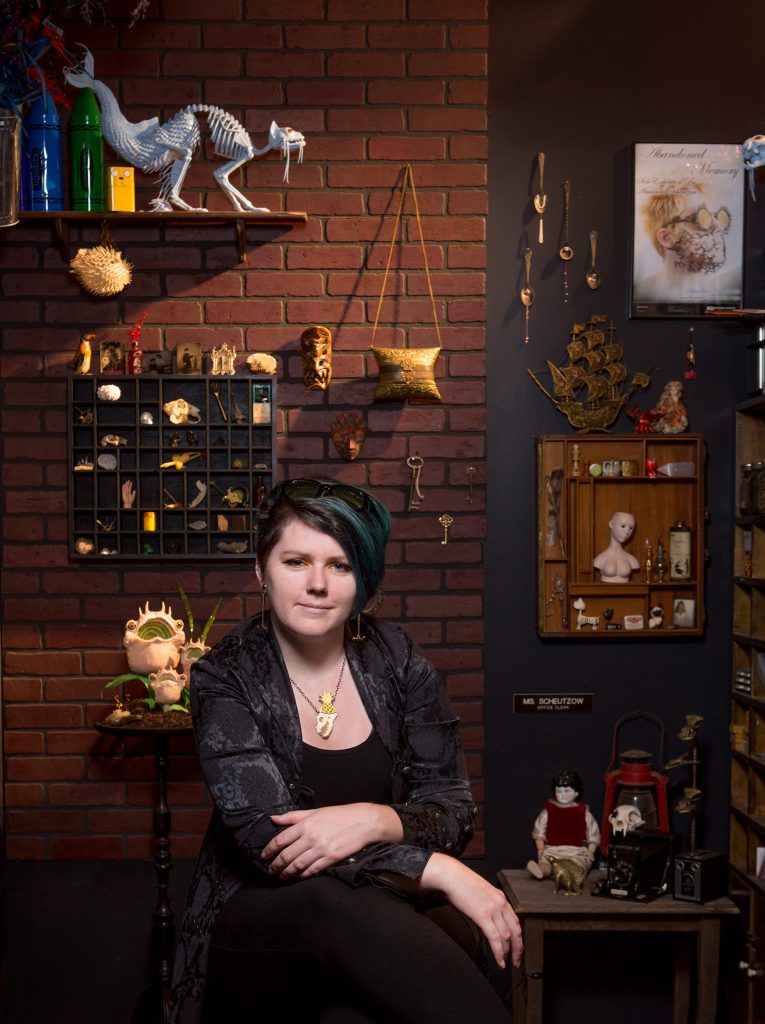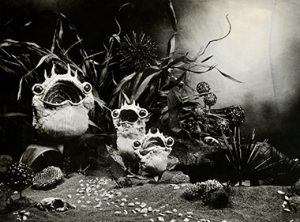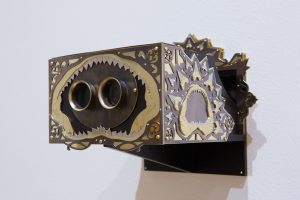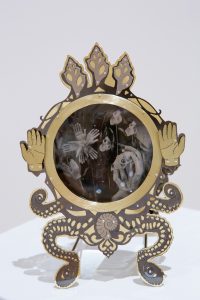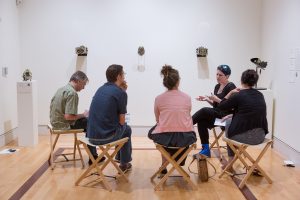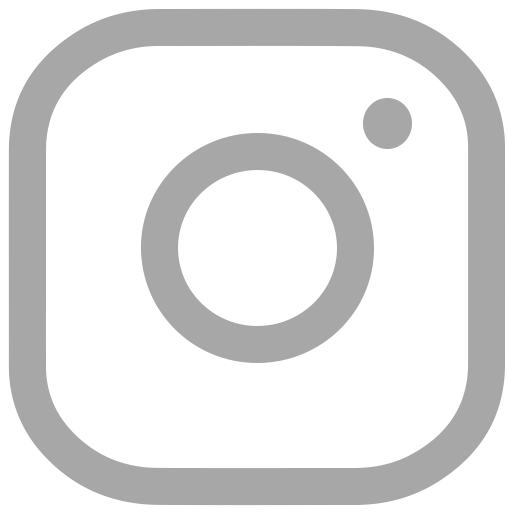Amanda Scheutzow, Artist: The Collector Making Art of her Own Cabinet of Curiosities
By: Cynthia Adams | Photos By: Nancy Evelyn
Designed and sculpted a la Alice in Wonderland, then photographed, Amanda Scheutzow’s work is developed in careful synchronicity that is glimpsed with an intricately designed viewer. Beware: this is a scary cool world of the artist’s own making.
By: Cynthia Adams | Photos By: Nancy Evelyn
As of this writing, artist Amanda Scheutzow has short blue hair and vivid blue eyes to match. Amanda Scheutzow, an artist with a recently earned MFA, expresses herself vividly, both in art and in her own person. Her hair, for example, was blue and long before she “decided to chop it off.” Before that it was bright green, red, and then purple. And the eyes, blue as they are…see life differently. As in, cinematographer Tim Burton different (she is just okay with that comparison, by the way.)
The worlds she explores artistically are neither fixed nor regimented. Only her work ethic is. She is work invested and exacting—color, after all, is merely one tool she employs in an arsenal that includes sculpting and welding. She can live as artfully as she wishes. “I ask, what color do I feel like today?” she announces, lightly shaking her blue locks.
Scheutzow was born in the coastal town of Newport News, Va., into a naval family. Her father, a nuclear engineer, was a scientist, tinkerer, and pragmatist. From him and others in her family, she developed a deep appreciation for how things work and the world of functionality, to a degree that equaled her fascination with the aesthetic of an object. Her grandfather designed a helicopter.
A thing well-wrought, whether mechanical or conceptual, is a thing which Scheutzow admires.
As a result, Scheutzow’s miniaturized compositions are so intricately created and imagined, they must be seen to be appreciated. Words fail. Anyone who ever owned a toy View MasterTM readily understands that the artist has elevated three-dimensional art to a multi-layered category all its own. In Scheutzow’s hands, both the mechanism (the viewer) to access the end visual (the tintypes) she creates are equally dynamic.
Scheutzow has a magpie eye. And anything arresting, shiny, or unusual, is claimed or else re-created. Her habitual gravitation to assemble and preserve as art first began as a form of collecting oddities.
“A lot of this has to do with collecting at first. I’ve been to like 14 different schools. My dad was in the military. He was in the Navy but typically in a shipyard. He was in the nuclear field, a nuclear engineer…not usually out to sea.”
Frequent moves required Scheutzow to detach from most of her belongings. “Every time we would pick up to move, we would have to gather up and dispose of a lot of things. I began to cultivate an identity through objects,” she explains. “I liked antiques, so I’d look and see how they were used or put together (my dad’s line) always looking at craftsmanship and artistry.” When Scheutzow completed her MFA exhibition this year, the 2017 MFA catalog stated, “Her installation for the MFA Thesis Exhibition consists of intricate and surreal stereoscope tintypes that are set up near carefully curated cabinets of curiosities.”
UGA art historian Abigail Kosberg added, “Amanda Scheutzow’s work toys with society’s innate need to collect and display precious objects. She looks at how, why and what people collect, investigating the need to curate and display an intimate personal collection.”
Scheutzow’s MFA showing was comprised of both the viewer and miniature vignettes, dioramas, or compositions like “Howlers” which as finished etched photographs are equally imaginative and just a tad Burton-esque creepy. Otherworldly.
(“I hope a place you want to inhabit,” she says with a mischievous smile.)
As Kosberg noted, “Her studio is packed with her collections: small objects and sculptures fill every shelf and available space, with each precious object tucked away in semi-permanent display. Her installation for the MFA Thesis Exhibition consists of intricate and surreal stereoscope tintypes that are set up near carefully curated cabinets of curiosities. Her collections exist in a disorienting state, caught between fiction and reality, resembling uncanny and hyperrealistic dioramas.”
She muses. “Could I have had a life that wasn’t in art but would have been archaeology or the study of ancient cultures and objects?”
Yes, Scheutzow decides. She adds pensively, “I collect to remember.”
“I started collecting odd things, like bones, or really weird things that made sense to me.” The vignettes she creates are perhaps most defined by something Victorians called “cabinets of curiosities.”
“I’d rearrange and make my own cabinet of curiosity. Technically, the Renaissance began it, but Victorians took it to whole new levels of intensity.”
Scheutzow pulls her compositions from taxidermy, much like Victorians did. She studies the display of preserved creatures in their natural, or unnatural habitats, and cites Walter Potter, a Victorian taxidermist, as an influence.
The scenes viewed are like miniature dioramas. And yet, she pushes away from that descriptor as well with undisguised
distaste.
“It reminds me of 3rd grade when you made those shoe box things,” Scheutzow says with just a tiny shudder. “I tried describing them as ‘tableaus’, but that doesn’t roll off the tongue.” A professor at UGA noted that Scheutzow kept calling them “characters, and sets, movie language.” She said, “That felt more normal.”
She sculpts the creatures, then places them within a scene which she constructs, makes the photograph, and also creates the mechanism to view them by in three dimensions.
The steps to produce Scheutzow’s art requires that she employ a multitude of skills—from conceptualization to welding and sculpting to photography.
Each aspect of the work is handmade and sculpted after she has first designed the composition. Afterward, she photographs them (with old fashioned box cameras) and produces tintypes. And finally, Scheutzow must build the viewer— which is a feat in itself.
Once glimpsed via the jewel-like viewers she has created—the tiny compositions are best described as miniature sets, macabre and magical all at once—one fully enters into Scheutzow’s imaginative worlds.
- Photo Credit: Amanda Sheutzow: The “Howlers” are one of the miniature sculptures that Scheutzow presented at her MFA show. Each aspect is individually sculpted.
- Photo Credit: Amanda Sheutzow
- Photo Credit: Amanda Sheutzow
- Photo Credit: Amanda Sheutzow: Scheutzow discussed her exhibition last May.
These are elaborate and artful insider jokes, wink-wink allusions that elicit smiles and outright howling laughter. For example, a fish skeleton Scheutzow has fashioned naughtily appears to wag a bushy tail. (“Ha! That’s a catfish!” she points out, laughing aloud.)
And, by the way, she likes to eat barbecued catfish, an admission after a lively discussion of how repellent some find them. (Me, namely.) The squeamish-inducing factor of the bottom-feeding catfish only serves to delight her.
Scheutzow discusses other mutated creations, including her birds, which are called “the Watchers.” Again, the tiny tableaus featuring these apocalyptic birds are jarring yet meaningful…artful, yet somehow musing.
Now working in San Francisco since completing her degree this year, Scheutzow is employed in a high-end “bench jewelry” store. Bench jewelers are somewhat rare in a world that is increasingly mass-produced, as bench jewelers must do hands-on work and crafting. This is a world she can readily slip into; after all, it was where she first plied her skills.
Having pursued the art of jewelry making, long before she was producing viewers and her own tintypes, jewelry making is something Scheutzow still employs in the painstaking work of her elaborately designed art installations. Therefore, a small music box is jewel-like and so intricately made that she admits it is the “only thing her father has asked for”—a point of pride. The same craftsmanship evidenced by the music box is visible in the viewers she designs and builds.
She has serially mastered many art forms en route to her present focus. After studying media arts and animation, she entered Arizona State University and began to work with sculpture.
“I took color theory and 3-D design class, and metals,” she says. This wide-ranging pursuit of visual and applied studies led to a dazzling number of skills which she began to pursue. For example, Scheutzow opens multiple boxes of hand-made jewelry she created and sold at art fairs.
The cabochon settings and wrought silver settings are something she mastered and produced with a deft hand. By doing certain work again and again, the artistic progression towards mastery is obvious—she, like many outliers, shows she has invested thousands of hours in learning the skill.
Her jewelry work is intricate and also arresting—once she learned the basics she soon innovated and found she enjoyed silver casting. As she works she often listens to international music and alternative musicians. “South African hip hop, rock and roll, metal, pirate metal,” Scheutzow says.
And she still collects. Especially tintypes, daguerreotypes, and vintage photography. She is still influenced by taxidermists, and her favorite influences are wide and eclectic.
“The goal is, as long as I can, to do my art,” she says.
The “Howlers” are one of the miniature sculptures that Scheutzow presented at her MFA show. Each aspect is individually sculpted. At bottom, Scheutzow discusses her exhibition last May.


